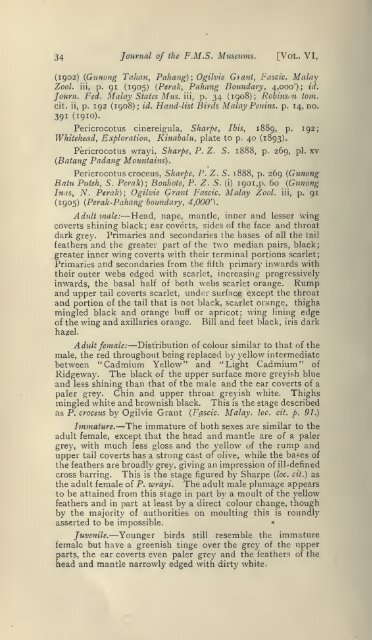Journal of the Federated Malay States museums - Sabrizain.org
Journal of the Federated Malay States museums - Sabrizain.org
Journal of the Federated Malay States museums - Sabrizain.org
You also want an ePaper? Increase the reach of your titles
YUMPU automatically turns print PDFs into web optimized ePapers that Google loves.
34 <strong>Journal</strong> <strong>of</strong> <strong>the</strong> F.M.S. Museums. [Vol. VI,<br />
(1902) (Gunong Tahan, Pahang); Ogilvie Giant, Fascic. <strong>Malay</strong><br />
Zool. iii, p. 91 (1905) {Pernk, Pahang Boundary, 4,000'); id-<br />
Journ. Fed. <strong>Malay</strong> <strong>States</strong> Mus. iii, p. 34 (1908); Robmsi'U torn.<br />
cit. ii, p. 192 (1908); id. Hand-list Birds <strong>Malay</strong> Penins. p. 14, no.<br />
391 (1910).<br />
Pericrocotus cinereigula, Sharpe, Ibis, 1889, p. 192;<br />
Whitehead, Exploration, Kinabalu, plate to p. 40 (1893).<br />
Pericrocotus wrayi, Sharpe, P. Z. S. 1888, p. 269, pi. xv<br />
(Batang Padang Mountains).<br />
Pericrocotus croceus, Sharpe, P. Z. S. 1888, p. 269 {Gunong<br />
Batu Puteh, S. Perak); Bonhote, P. Z. S. (i) igoi,p. 60 {Gunong<br />
Injs, N. Perak); Ogilvie Grant Fascic. <strong>Malay</strong> Zool. iii, p. 91<br />
(1905) {Perak-Pahang boundary, 4,000').<br />
Adult male:— Head, nape, mantle, inner and lesser wing<br />
coverts shining black; ear coverts, sides <strong>of</strong> <strong>the</strong> face and throat<br />
dark grey. Primaries and secondaries <strong>the</strong> bases <strong>of</strong> all <strong>the</strong> tail<br />
fea<strong>the</strong>rs and <strong>the</strong> greater part <strong>of</strong> <strong>the</strong> two median pairs, black;<br />
greater inner wing coverts with <strong>the</strong>ir terminal portions scarlet;<br />
Primaries and secondaries from <strong>the</strong> fifth primary inwards with<br />
<strong>the</strong>ir outer webs edged with scarlet, increasing progressively<br />
inwards, <strong>the</strong> basal half <strong>of</strong> both webs scarlet orange. Rump<br />
and upper tail coverts scarlet, under surface except <strong>the</strong> throat<br />
and portion <strong>of</strong> <strong>the</strong> tail that is not black, scarlet orange, thighs<br />
mingled black and orange buff or apricot; wing lining edge<br />
<strong>of</strong> <strong>the</strong> wing and axillaries orange. Bill and feet black, iris dark<br />
hazel.<br />
Adult female:—Distribution <strong>of</strong> colour similar to that <strong>of</strong> <strong>the</strong><br />
male, <strong>the</strong> red throughout being replaced by yellow intermediate<br />
between "Cadmium Yellow" and "Light Cadmium" <strong>of</strong><br />
Ridgeway. The black <strong>of</strong> <strong>the</strong> upper surface more greyish blue<br />
and less shining than that <strong>of</strong> <strong>the</strong> male and <strong>the</strong> ear coverts <strong>of</strong> a<br />
paler grey. Chin and upper throat greyish white. Thighs<br />
mingled white and brownish black. This is <strong>the</strong> stage described<br />
as P. croceus by Ogilvie Grant {Fascic. <strong>Malay</strong>, loc. cit. p. 91.)<br />
Immature.—The immature <strong>of</strong> both sexes are similar to <strong>the</strong><br />
adult female, except that <strong>the</strong> head and mantle are <strong>of</strong> a paler<br />
grey, with much less gloss and <strong>the</strong> yellow <strong>of</strong> <strong>the</strong> rump and<br />
upper tail coverts has a strong cast <strong>of</strong> olive, while <strong>the</strong> bases <strong>of</strong><br />
<strong>the</strong> fea<strong>the</strong>rs are broadly grey, giving an impression <strong>of</strong> ill-defined<br />
cross barring. This is <strong>the</strong> stage figured by Sharpe {loc. cit.) as<br />
<strong>the</strong> adult female <strong>of</strong> P. wrayi. The adult male plumage appears<br />
to be attained from this stage in part by a moult <strong>of</strong> <strong>the</strong> yellow<br />
fea<strong>the</strong>rs and in part at least by a direct colour change, though<br />
by <strong>the</strong> majority <strong>of</strong> authorities on moulting this is roundly<br />
asserted to be impossible.<br />
•<br />
Juvenile.—Younger birds still resemble <strong>the</strong> immature<br />
female but have a greenish tinge over <strong>the</strong> grey <strong>of</strong> <strong>the</strong> upper<br />
parts, <strong>the</strong> ear coverts even paler grey and <strong>the</strong> fea<strong>the</strong>rs <strong>of</strong> <strong>the</strong><br />
head and mantle narrowly edged with dirty white.

















